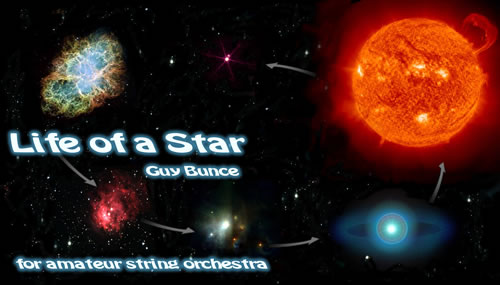Written for Yorkshire Late Starters Strings
Life of a Star was written especially for ‘Yorkshire Late Starters Strings’ and depicts the life cycle of a star. The piece is divided into five sections which progress without any pauses:
1: Nebula
A Nebula is the term used for a region of space in which the formations of gas dust and other space material begin to cluster together. As a result the mass and gravity increases, attracting further matter. The opening section of Life of a Star depicts the emptiness of a Nebula prior to the gravitational collapse that leads to the formation of a Protostar. Ideas and motifs are explored in this section but they are cut short. Often, a Nebula begins to form when some event takes place causing the initial attraction of matter. This ‘event’ occurs about half way through the first section (b.38) leading to creation of a
Protostar.
2: Protostar
A Protostar forms as matter gradually compacts causing the centre (or core) to heat up. In this section of the piece the ‘centre’ of the texture begins to become denser, beginning with the Violins 2b and gradually attracting the other lines. As the section continues, the tessitura of the music narrows until the focus is on four notes (C, C#, D, F#) – the motifs from which all material for the piece is derived. The tessitura continues to contract depicting the Protostar reaching 15,000,000 degree centigrade.
3: Main Sequence: Chorale
The high temperature reached by the Protostar causes nuclear fusion of hydrogen to form helium, thus the star begins its main sequence. This section of the piece consists of a pulsating chorale interspersed with solo sections. The texture is often thick and the tessitura is wide and the ‘core’ (or middle of the texture) holds the music together through the devise of an inner pedal. Over time, the star gradually becomes unstable in its core as the hydrogen runs out. The piece depicts this through the appearance of pizzicato/col legno in the ‘core’ (Violas and Cello b).
4: Red Giant
As the helium core runs out, the outer layers drift away from the core as a gaseous shell, resulting in the star shining less brightly. The tempo at this point begins to decrease and the centre becomes more unstable along with the tessitura of the music becoming wider until only the 1st violins (a) and the double basses are left. The timbre becomes ‘icy’ as the remnants of the star cool. Fragments from the first section return.
5: White Dwarf
As the gaseous shell disappears, what is left is the remaining shining core or ‘white dwarf’ – represented by the dense improvisations around a limited range. White dwarfs gradually cool down until they stop shinning at which point the star is dead.
Life of a Star was written especially for ‘Yorkshire Late Starters Strings’ and depicts the life cycle of a star. The piece is divided into five sections which progress without any pauses:
1: Nebula
A Nebula is the term used for a region of space in which the formations of gas dust and other space material begin to cluster together. As a result the mass and gravity increases, attracting further matter. The opening section of Life of a Star depicts the emptiness of a Nebula prior to the gravitational collapse that leads to the formation of a Protostar. Ideas and motifs are explored in this section but they are cut short. Often, a Nebula begins to form when some event takes place causing the initial attraction of matter. This ‘event’ occurs about half way through the first section (b.38) leading to creation of a
Protostar.
2: Protostar
A Protostar forms as matter gradually compacts causing the centre (or core) to heat up. In this section of the piece the ‘centre’ of the texture begins to become denser, beginning with the Violins 2b and gradually attracting the other lines. As the section continues, the tessitura of the music narrows until the focus is on four notes (C, C#, D, F#) – the motifs from which all material for the piece is derived. The tessitura continues to contract depicting the Protostar reaching 15,000,000 degree centigrade.
3: Main Sequence: Chorale
The high temperature reached by the Protostar causes nuclear fusion of hydrogen to form helium, thus the star begins its main sequence. This section of the piece consists of a pulsating chorale interspersed with solo sections. The texture is often thick and the tessitura is wide and the ‘core’ (or middle of the texture) holds the music together through the devise of an inner pedal. Over time, the star gradually becomes unstable in its core as the hydrogen runs out. The piece depicts this through the appearance of pizzicato/col legno in the ‘core’ (Violas and Cello b).
4: Red Giant
As the helium core runs out, the outer layers drift away from the core as a gaseous shell, resulting in the star shining less brightly. The tempo at this point begins to decrease and the centre becomes more unstable along with the tessitura of the music becoming wider until only the 1st violins (a) and the double basses are left. The timbre becomes ‘icy’ as the remnants of the star cool. Fragments from the first section return.
5: White Dwarf
As the gaseous shell disappears, what is left is the remaining shining core or ‘white dwarf’ – represented by the dense improvisations around a limited range. White dwarfs gradually cool down until they stop shinning at which point the star is dead.



